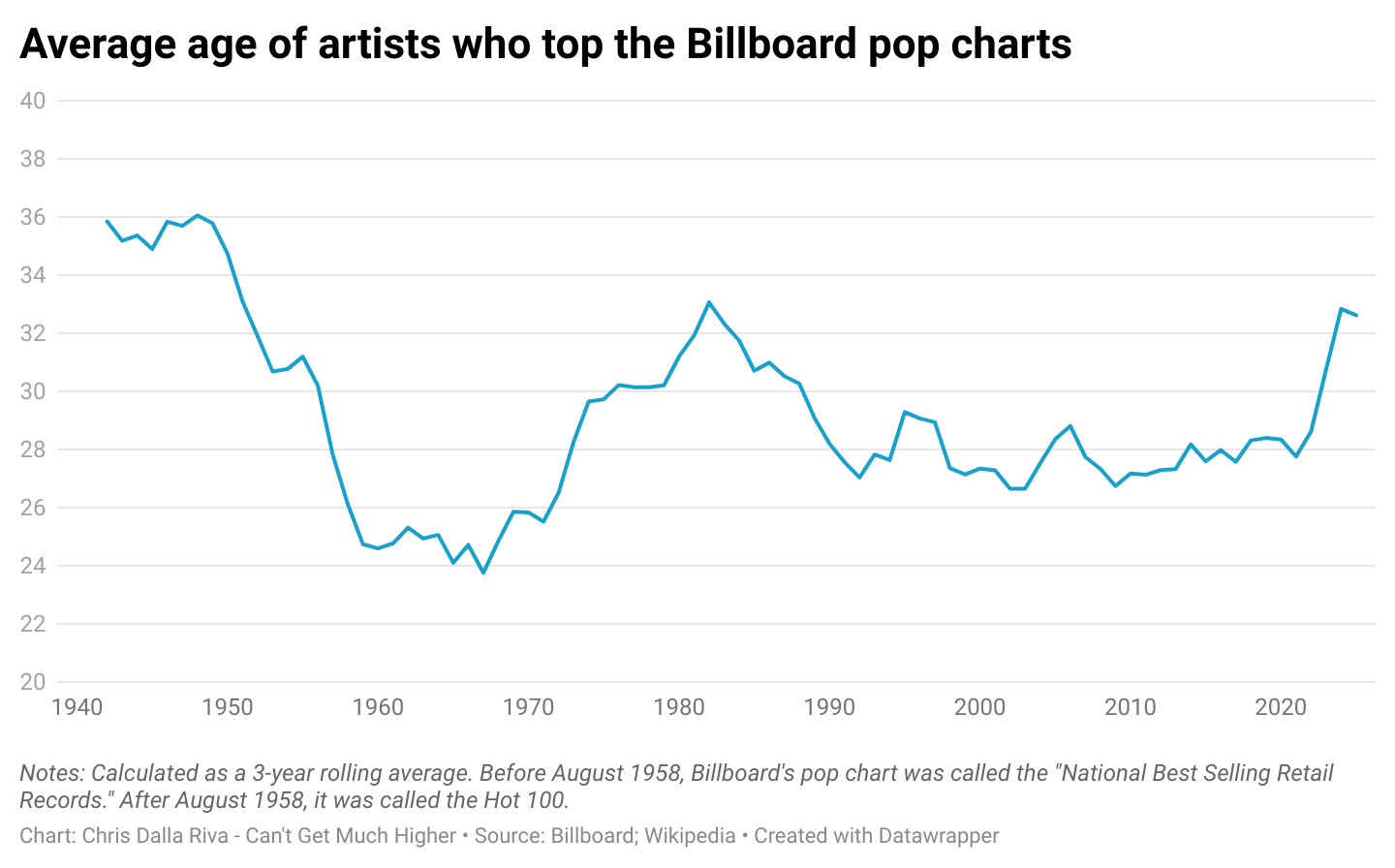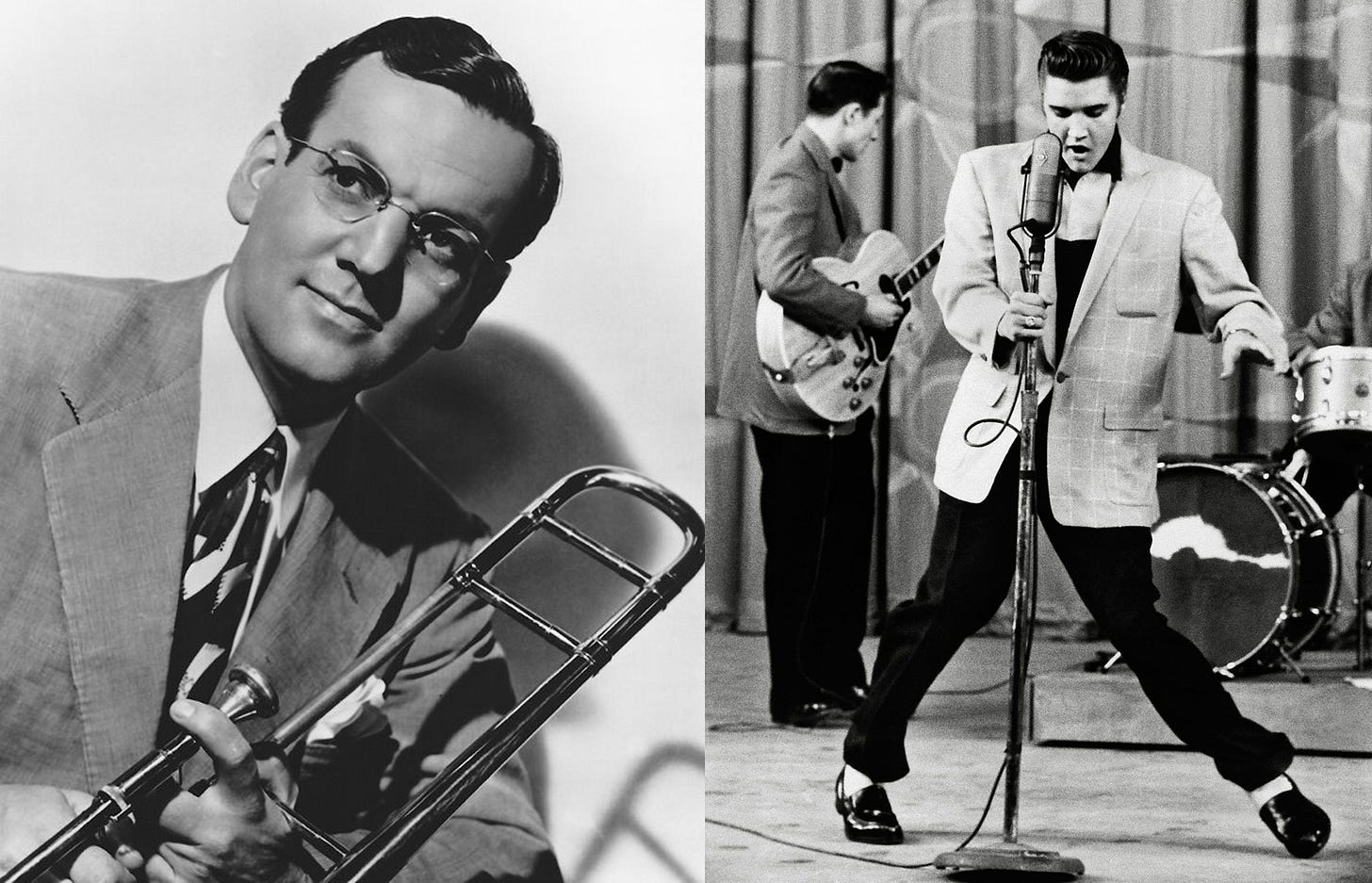The Return of the "Elderly" Pop Star
Or, how 40 is the new 20
Before we talk about the pop music gerontocracy, I wanted to remind you that my debut book Uncharted Territory: What Numbers Tell Us about the Biggest Hit Songs and Ourselves is coming out soon. It’s a data-driven history of popular music covering 1958 to 2025. If you’ve already purchased a copy, thank you so much! If you’re still not convinced, I hope the quality of this week’s piece changes your mind.
The Return of the "Elderly" Pop Star
By Chris Dalla Riva
When Bruce Springsteen was signed to a Columbia Records in the early 1970s, he was among a small group of artists dubbed the “new Dylan.” Decades later, he joked about this nickname while giving the keynote address at South by Southwest:
I was signed as an acoustic singer/songwriter … by John Hammond at Columbia Records, along with Elliott Murphy, John Prine, [and] Loudin Wainwright III. We were all new Dylans. And the old Dylan was only 30. So, I don’t even know why they needed a fucking new Dylan, all right? But those were the times.
Dubbing all of these artists the “new Dylan” is especially funny when you realize at this point the real Dylan hadn’t even released Blood on the Tracks, what many people argue is his greatest record. Still, part of me understands why people were in search of a new Dylan. And it’s not because some people criticize his early 1970s work as inferior. It’s because most people make it on the pop music scene when they are quite young.
Before Paul McCartney turned 28, The Beatles had already broken up.
Before Stevie Wonder turned 27, he had released 18 albums, including the flawless foursome, Talking Book (1972), Innervisions (1973), Fulfillingness' First Finale (1974), and Songs in the Key of Life (1976).
Before Billie Eilish could legally drink alcohol, she had sold millions of records, topped the Billboard Hot 100, and won both an Oscar and a Grammy.
Even Bob Dylan illustrates this trend. By the time he was 26, he’d already redefined both rock and folk music by “going electric,” along with releasing seven records, at least five of which are considered classics. Though music is a lifelong pursuit, pop stardom is a young person’s game. But something weird has been going on recently.
Part of the reason that I wrote a data-driven history of popular music is because years ago I decided to listen to every song to ever top the Billboard Hot 100. While I was doing that, I tracked a ton of information about those songs, including each artist’s age when they topped the charts. In the grand scheme of things, pop stars are young. Between 1940 and 2025, the average age of a chart-topping artist never goes above 36. Still, there are some wild swings that deserve clarification.
From 1940 to 1950, pop stars were regularly in their mid-30s. Then they start to age backwards. By 1960, your average pop star is a decade younger than their counterparts in the 1940s. Why did this happen? One word: Teenagers.
Again, I discuss this in my book, but the idea that there was a distinct demographic group between childhood and adulthood is an invention of the 20th century. As this group became larger and more powerful, they began to differentiate their musical tastes from their parents and younger siblings. The music industry began to take note of this and promoted stars that were demographically closer to the teenagers that were buying records. This is part of the reason you end up from pop stars going from looking like Glenn Miller to Elvis Presley.
Throughout the 1960s, this model persisted. You had relatively young people making music marketed to relatively young people. This trend then reversed from around 1970 to 1982. During that period, your average pop star goes from 24 to 32.
I dedicate the first half of chapter four in my book to this topic, but much of it is related to the dissolution of musical groups at the end of the 1960s. You had members of The Beatles and The Supremes and The Temptations all pursuing solo careers at once, along with hit songwriters from the same decade, like Neil Diamond and John Denver. Naturally, these stars were older because they were effectively starting a second career.
But this trend was not to survive. The mid-30s pop star was to remain a relic of the 1940s. From 1990 to 2020, pop stars were regularly around 26 to 28, not as young as those in the 1960s but certainly not old. But then over the last 5 years, the “elderly” pop star has returned. As of the last three years, the average chart-topping artist was 33. Again, not old in the grand scheme of things but old in the world of pop music. What’s going on?
Keep reading with a 7-day free trial
Subscribe to Can't Get Much Higher to keep reading this post and get 7 days of free access to the full post archives.




